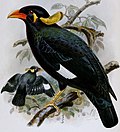Superregnum: Eukaryota
Regnum: Animalia
Subregnum: Eumetazoa
Cladus: Bilateria
Cladus: Nephrozoa
Superphylum: Deuterostomia
Phylum: Chordata
Cladus: Craniata
Subphylum: Vertebrata
Infraphylum: Gnathostomata
Superclassis: Tetrapoda
Cladus: Reptiliomorpha
Cladus: Amniota
Classis: Reptilia
Cladus: Eureptilia
Cladus: Romeriida
Subclassis: Diapsida
Cladus: Sauria
Infraclassis: Archosauromorpha
Cladus: Crurotarsi
Divisio: Archosauria
Subsectio: Ornithodira
Subtaxon: Dinosauromorpha
Cladus: Dinosauria
Ordo: Saurischia
Cladus: Theropoda
Cladus: Neotheropoda
Infraclassis: Aves
Ordo: Passeriformes
Subordo: Passeri
Infraordo: Passerida
Superfamilia: Muscicapoidea
Familia: Sturnidae
Genus: Gracula
Species: G. enganensis – G. indica – G. ptilogenys – G. religiosa – G. robusta
Nomen dubium: G. barita
Name
Gracula Linnaeus, 1758
Gender: feminine
Type species: Gracula religiosa Linnaeus, 1758
References
Linnaeus, C. 1758. Systema Naturae per regna tria naturae, secundum classes, ordines, genera, species, cum characteribus, differentiis, synonymis, locis. Editio Decima, Reformata. Tomus I. Holmiæ (Stockholm): impensis direct. Laurentii Salvii. 824 pp. DOI: 10.5962/bhl.title.542 [first availability: page 108] BHL Reference page.
Vernacular names
English: Myna
suomi: Pyhämainat
Bahasa Indonesia: Beo
ไทย: นกเอี้ยงคำ, นกขุนทอง
Gracula is a genus of mynas, tropical members of the starling family of birds found in southern Asia and introduced to Florida in the United States.
Contents
Taxonomy
The genus Gracula was introduced in 1758 by the Swedish naturalist Carl Linnaeus in the tenth edition of his Systema Naturae.[1] The genus name is from Latin graculus, an unknown bird sometimes identified as the western jackdaw.[2] Of the seven species listed by Linnaeus, George Gray designated the common hill myna (Gracula religiosa) as the type species.[3][4]
Until recently only two species were recognised, G. religiosa and G. ptilogenys. Previously, all Gracula were considered to belong to a very variable species commonly called the hill myna. Three additional subspecies of G. religiosa are increasingly being considered as distinct species. Formerly, the Sri Lanka hill myna was considered to be a subspecies of the common hill myna, but today all major authorities recognise them as separate. Comparably, the Enggano, Nias and southern hill mynas have traditionally been treated as subspecies of the common hill myna; a treatment still preferred by some authorities.
Species
Five extant species are recognized:[5]
| Image | Scientific name | Common Name | Distribution |
|---|---|---|---|
 |
Gracula ptilogenys | Sri Lanka hill myna | Sri Lanka. |
 |
Gracula religiosa | Common hill myna | Nepal, Sikkim, Bhutan and Arunachal Pradesh, the lower Himalayas |
 |
Gracula indica | Southern hill myna | southwest India and Sri Lanka |
 |
Gracula robusta | Nias hill myna | Nias and other nearby islands off western Sumatra. |
| Gracula enganensis | Enggano hill myna | Enggano Island, off southwest Sumatra. |
A 2020 study found that the subspecies G. religiosa miotera or Simeulue hill myna, which is endemic to Simeulue, Indonesia and has not been recognized in recent taxonomic arrangements aside from HBW (Handbook of the Birds of the World), also likely represents a distinct species and was likely driven to extinction in the wild in the late 2010s due to unsustainable collecting for the wildlife trade. The paper recommends rescuing the last genetically pure captive individuals for the purpose of captive breeding.[6]
Former species
Formerly, some authorities also considered the following species (or subspecies) as species within the genus Gracula:
Magpie-lark (as Gracula picata)
Description
These 25–30 cm (9.8–11.8 in) long birds have glossy black plumage and large white wing patches which are obvious in flight. The bill and strong legs are bright yellow or orange, and there are yellow wattles on the head, the shape and position of which vary with species. The sexes are similar, but juveniles have a duller bill.
Vocalisations
Hill mynas are renowned for their ability to mimic the human voice. It has been claimed that the hill mynah is the best talking bird and the best mimic in the world.[7]
Distribution and habitat
This genus has representatives in tropical southern Asia from India, Bangladesh and Sri Lanka east to Indonesia, and the common hill myna, a popular cage bird, has been introduced to the United States.
Behaviour and ecology
Breeding
The hill mynas are resident breeders typically found in forest and cultivation. The nest is built in a hole and the usual clutch is two or three eggs.
Food and feeding
Like most starlings, the hill mynas are fairly omnivorous, eating fruit, nectar and insects.
References
Linnaeus, Carl (1758). Systema Naturae per regna tria naturae, secundum classes, ordines, genera, species, cum characteribus, differentiis, synonymis, locis (in Latin). Volume 1 (10th ed.). Holmiae (Stockholm): Laurentii Salvii. p. 108.
Jobling, James A. (2010). The Helm Dictionary of Scientific Bird Names. London: Christopher Helm. p. 176. ISBN 978-1-4081-2501-4.
Gray, George Robert (1840). A List of the Genera of Birds : with an Indication of the Typical Species of Each Genus. London: R. and J.E. Taylor. p. 39.
Mayr, Ernst; Greenway, James C. Jr, eds. (1962). Check-list of birds of the world. Volume 15. Cambridge, Massachusetts: Museum of Comparative Zoology. p. 118.
"IOC World Bird List 7.1". IOC World Bird List Datasets. doi:10.14344/ioc.ml.7.1.
Ng, Dominic Y. J.; Švejcarová, Tereza; Sadanandan, Keren R.; Ferasyi, Teuku Reza; Lee, Jessica G. H.; Prawiradilaga, Dewi M.; Ouhel, Tomáš; Ng, Elize Y. X.; Rheindt, Frank E. (2021). "Genomic and morphological data help uncover extinction-in-progress of an unsustainably traded hill myna radiation". Ibis. 163 (1): 38–51. doi:10.1111/ibi.12839. ISSN 1474-919X.
Butterfield, Kathy. "Owning a Mynah". The AACC Homepage. Archived from the original on 2015-07-12. Retrieved 2015-09-21.
Grimmett, Richard; Inskipp, Carol; Inskipp, Tim (1999). Birds of India. Princeton University Press. ISBN 0-691-04910-6.
Feare, Chris; Craig, Adrian (1999). Starlings and Mynas. Princeton University Press. ISBN 0-7136-3961-X.
Retrieved from "http://en.wikipedia.org/"
All text is available under the terms of the GNU Free Documentation License

